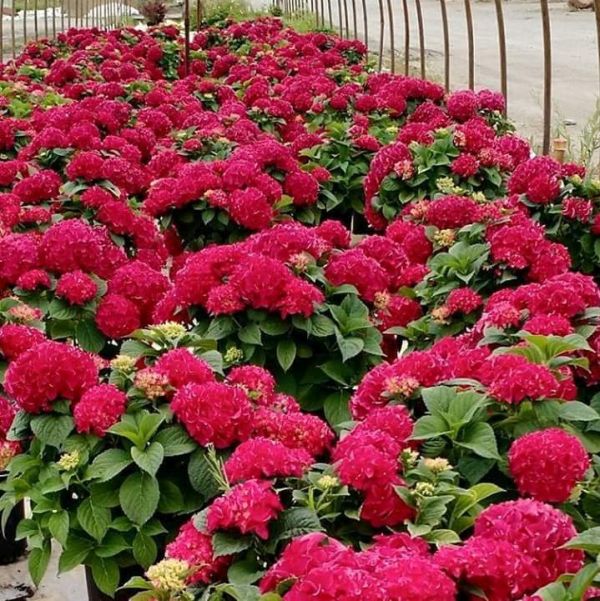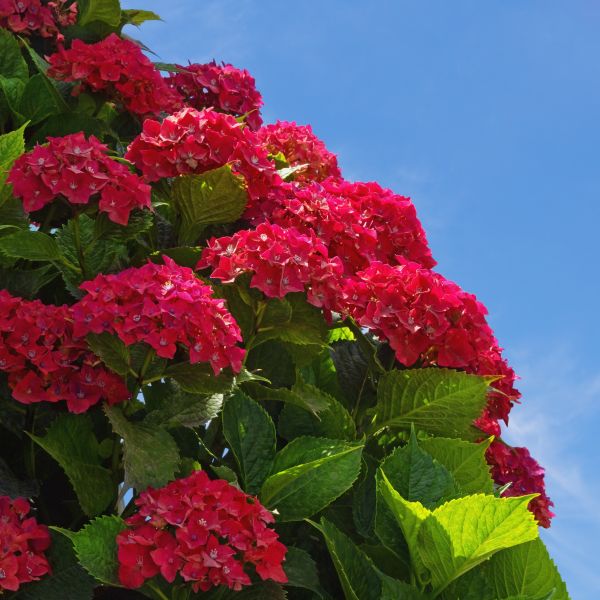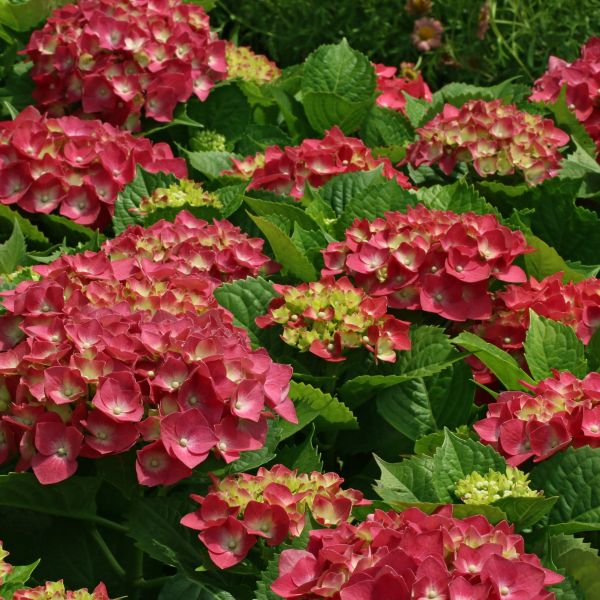


Grateful Red Hydrangea
Hydrangea macrophylla 'McKRed'
89 reviews
Grateful Red Hydrangea
Hydrangea macrophylla 'McKRed'
89 reviews
2.5 Gallon
We are sorry, product is currently out of stock due to seasonal availability. Please check the "Related plants available in your area" section below
Not just beautiful - intentionally selected by ShrubHub's 3D landscape design team to fit real-world spaces and maximize yard potential.
Why Grateful Red Hydrangea?
The Grateful Red Hydrangea is a stunning variety of the Hydrangea macrophylla that features deep red blooms that are revered for their vibrant and eye-catching aesthetic. This cultivar is notable for its impressive heat tolerance, making it an ideal choice for warmer regions. Its compact, well-behaved size also makes it perfect for containers or small gardens. The Grateful Red Hydrangea is truly a standout plant that is sure to impress.
Sunlight
Grateful Red Hydrangea thrives in partial shade to full sun, with a minimum requirement of 4 to 6 hours of direct sunlight each day.
Watering
Grateful Red Hydrangea requires regular watering, especially during hot and dry periods. It prefers moist, well-drained soil that is consistently damp but not waterlogged. Adequate watering helps to promote healthy growth and vibrant blooms.
Fertilizing
Grateful Red Hydrangeas thrive in well-drained soil with a pH level between 5.2 and 6.2. Adding a slow-release, balanced fertilizer in early spring is recommended, following the manufacturer's instructions. Regular application of compost or organic matter
The stunning and vibrant Grateful Red Hydrangea - a show-stopping hydrangea that is sure to captivate and impress. Flourishing in a variety of climates, this magnificent plant thrives in USDA hardiness zones 4 to 9, bringing a pop of color to your garden no matter where you live.
With its striking red blooms that are impossible to miss, the Grateful Red Hydrangea is perfect as a statement piece, a hedge, or as a focal point in your landscape. Imagine stepping outside to be greeted by the vibrant shades of red that this hydrangea has to offer, creating a bold and captivating display that is sure to impress.
Fertilize this beauty in early spring with a balanced slow-release fertilizer to ensure optimal growth and blooming potential. The Grateful Red Hydrangea prefers well-drained, acidic soils, but can adapt to other soil types, making it a versatile addition to any landscape.
With minimal maintenance requirements, this hydrangea is a gardener's dream come true. Simply prune any dead or diseased wood and enjoy the abundance of stunning blooms year after year.
Not only does the Grateful Red Hydrangea delight with its vibrant blooms and effortless beauty, but it also attracts a multitude of pollinators to your garden. Bees, butterflies, and other beneficial insects are drawn to the nectar-rich blossoms, making this hydrangea a hub of activity and biodiversity.
Immerse yourself in the beauty of the Grateful Red Hydrangea, with its eye-catching blooms, striking form, and effortless elegance. Whether used in containers or garden beds the Grateful Red Hydrangea is a versatile and stunning addition to any garden. Prepare to be grateful for the brilliant hues of this exceptional plant that bring vibrant pops of color to your garden like no other.
Plant Information:
| Botanical Name: | Hydrangea macrophylla 'McKRed' |
| USDA Zones: | 4 - 9 |
| Water: | Moderate |
| Exposure: | Full Sun |
| Soil Needs: | Adaptable |
| Mature Height: | 3 - 4 feet |
| Mature Spread: | 2 - 3 feet |







Pollination Info
Pollination Information for Grateful Red Hydrangea (Hydrangea macrophylla 'McKRed')
Grateful Red Hydrangea (Hydrangea macrophylla 'McKRed') is a member of the Hydrangea family, and like other members of this family, it is a deciduous shrub that produces large, showy blooms in the summer. The blooms of the Grateful Red Hydrangea are deep red, and they attract a variety of pollinators, including bees, butterflies, and hummingbirds.
Pollination Requirements
Grateful Red Hydrangeas are self-fertile, which means that they are able to produce fruit and seeds without the need for cross-pollination. However, cross-pollination with other plants can increase the genetic diversity of the offspring, resulting in healthier and stronger plants.
Pollination Methods
The most common method of pollination for Grateful Red Hydrangeas is insect pollination. Bees, butterflies, and hummingbirds are all attracted to the brightly-colored blooms of the Grateful Red Hydrangea and will visit them to feed on nectar and pollen. As they move from flower to flower, they unwittingly transfer pollen from one flower to another, fertilizing the plant in the process.
Pollination Timing
The Grateful Red Hydrangea blooms in the summer, typically from June to August. This is the time when pollinators are most active, so it is the ideal time for the plant to be pollinated.
Pollination Tips
- Plant multiple Grateful Red Hydrangeas to encourage cross-pollination.
- Plant other plants that attract pollinators nearby to increase pollination rates.
- Avoid using insecticides and other chemicals that can harm pollinators.
FAQ
Grateful Red Hydrangea (Hydrangea macrophylla 'McKRed') FAQ
What is the Grateful Red Hydrangea?
The Grateful Red Hydrangea (Hydrangea macrophylla 'McKRed') is a deciduous shrub that produces large cluster blooms of red-pink colored flowers in the summertime. Its foliage is a deep green color and has a glossy texture.
What kind of soil does the Grateful Red Hydrangea prefer?
The Grateful Red Hydrangea prefers a well-draining, slightly acidic soil with a pH between 5.0 to 6.5. It also benefits from soil that is high in organic matter such as compost or aged manure.
What type of sunlight does the Grateful Red Hydrangea require?
The Grateful Red Hydrangea prefers partial sunlight to partial shade. It can tolerate some direct sunlight, but too much can damage the plant and cause the blooms to fade.
How often should I water the Grateful Red Hydrangea?
The Grateful Red Hydrangea requires consistent moisture, but not too much water. It is recommended to water the plant deeply once a week, or more frequently during times of drought. Avoid overwatering or letting the soil dry out completely between waterings.
How tall and wide does the Grateful Red Hydrangea grow?
The Grateful Red Hydrangea typically grows to be 3 to 5 feet tall and wide, with a rounded shape.
When does the Grateful Red Hydrangea bloom?
The Grateful Red Hydrangea blooms in the summertime, typically starting in late June and continuing through August.
How do I prune the Grateful Red Hydrangea?
The Grateful Red Hydrangea should be pruned in the late winter or early spring before new growth appears. Dead or damaged wood should be removed, and the remaining branches should be cut back by about one-third to promote new growth and flowering.
Can I grow the Grateful Red Hydrangea in a container?
Yes, the Grateful Red Hydrangea can be grown in a container as long as it is the appropriate size and has good drainage. Use a high-quality potting mix and provide regular fertilization to encourage healthy growth.
Planting & Care
Planting & Care for Grateful Red Hydrangea (Hydrangea macrophylla 'McKRed')
Planting:
- Choose a location that gets morning sun and afternoon shade.
- Plant in well-drained, moist soil.
- Dig a hole twice as wide as the pot and equally deep.
- Remove the plant from the pot and loosen the roots.
- Place the plant in the hole and backfill with soil.
- Water thoroughly.
Care:
- Water regularly, especially during hot, dry weather.
- Mulch with 2-3 inches of organic material to retain soil moisture and control weeds.
- Fertilize in spring with a balanced, slow-release fertilizer.
- Prune to shape in late winter or early spring.
- Protect from harsh winter winds and frost by covering with burlap or other protective material.
Tips:
- Grateful Red hydrangeas are sensitive to soil pH. Test your soil and adjust if necessary to a pH of 5.5-6.5 for optimal growth.
- Deadhead spent blooms to encourage new growth and more blooms.
- If your hydrangea does not bloom, it may be due to pruning at the wrong time or too much nitrogen fertilizer.
Check Out These Verified Customer Reviews:
Customer Reviews
4.7 out of 5 based on 89 reviews
Thank you! Your review has been submitted.
Thriving in my garden
The Grateful Red Hydrangea looks stunning in my garden. The color is vibrant and the blooms are plentiful.
Absolutely love my Grateful Red Hydrangea. The colors are vibrant and the blooms are long-lasting. Can't wait to order more plants from this company!
Item has been added to your cart.


